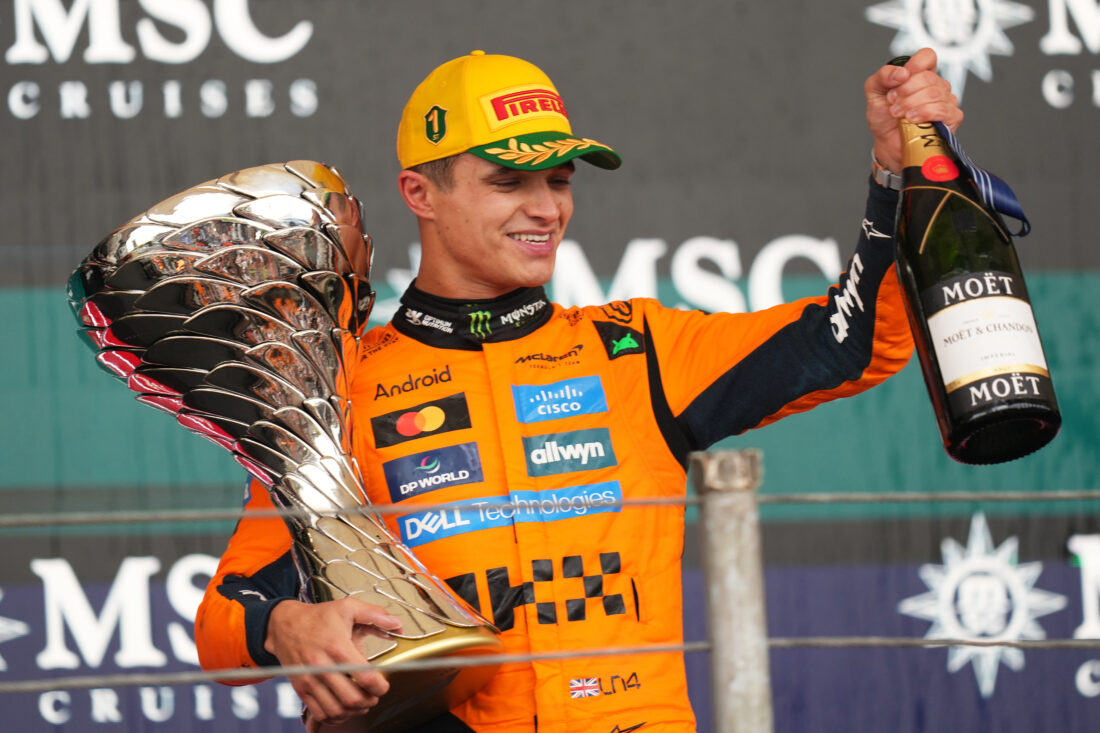F1 Review: Absolutely no absolutes

McLaren driver Lando Norris of Britain celebrates on the podium his first place in the Brazilian Formula One Grand Prix at the Interlagos race track in Sao Paulo, Sunday, Nov. 9, 2025. (AP Photo/Andre Penner)
SAO PAULO — Formula 1 (F1) seasons that unfold like the 2025 campaign are the ones that make me love watching the sport. Even though one team has been the most dominate, every race has still had a multitude of interesting events and the winner was seldom guaranteed. One thing that this season has shown me in particular is that there are absolutely no absolutes in F1.
And yet, the commentators fill the airwaves with absolutes during every session, something that has escalated as we approach the final three races with three legitimate contenders for the championship. Over the weekend, I heard commentators say things like: Oscar Piastri needs to have a good Free Practice session or he’ll struggle all weekend; Max Verstappen needs to get pole position for the race or his season is done; Lando Norris needs to keep up his momentum or he might lose it all.
While I understand the desire to get fans engaged and heighten excitement, the nature of these absolute claims tends to make fools of them by the time the race is done. It drives down my enjoyment of the racing, and it undercuts the amazing nature of this sport where so much is actually unpredictable.
Out of those earlier mentions, I’ll focus on Verstappen in his Red Bull car. Though Brazil had a lot of interesting on track action with Norris and Piastri, including a harsh and, in my opinion, illogical 10-second time penalty called on Piastri, Verstappen’s achievements in the race are worthy of a deeper dive. Especially since the commentators had unequivocally counted Verstappen out of the championship after qualifying 16th for the feature race.
In F1, usually a weekend has three practice sessions, then qualifying. They run an elimination based qualifying that sees three rounds: Q1, Q2 and Q3. At the end of 18 minutes for Q1, the drivers who set the five slowest times are eliminated. Q2 has 15 minutes on the timer, and again, the drivers who set the five slowest times are eliminated. That leaves 10 drivers to try and get pole in the final 12 minute session of Q3. After that, the starting grid order is set.
Verstappen has entered 230 races in his career and was eliminated in Q1 only seven times, one of which was this past weekend in Brazil. In his first season, Verstappen needed repairs done on his car and the team sent him out in the final minutes of Q1 to try and set a time when his engine cover came off, certainly an unexpected end to his qualifying attempt. That was his first.
He proceeded to have one Q1 elimination per year for the next four years, none of which were pace related. The four reasons, in order, included: crashing out in Monaco, his power unit quit, he crashed out again in Monaco, his power unit quit again. In 2020, he managed to get through the entire season without a single Q1 exit. In the 2021 Russian race, he had a grid penalty going into qualifying and the team was going to replace a number of things on his car that would put him in last place no matter what, so he didn’t even go out in qualifying at all. Then he had the amazing streak of no Q1 exits for the 2022, 2023, and 2024 seasons.
After qualifying sixth in the Sprint race on Friday and finishing the Sprint race in fourth position on Saturday, Verstappen suffered his first Q1 exit on pure pace on Saturday evening in Brazil. He was 0.219 seconds behind the 15th place Carlos Sainz and just couldn’t manage to find any pace in his car after a far more decent performance in the Sprint format. The changes the team made between the Sprint race and qualifying did not work.
Most other drivers would sit back and shrug, not knowing what really happened and sulk that Sunday would be a long race from that position. Most other drivers aren’t four-time world champions, though. Red Bull and Verstappen made problem solving their MO over the years. Verstappen struggles some throughout the weekend, laments the lack of speed in the car, then the team makes changes to the set up of his car and he makes magic on the track, usually pulling something good out of the jaws of defeat.
While commentators were already digging the grave for Verstappen, for the second time this season given his previous 100+ point gap in the Driver’s Championship, neither him nor his team were listening. They broke parc fermé conditions, guidelines set up in F1 that say a team can’t touch a car once qualifying has finished, and made more set up changes to Verstappen’s car. The cost? He had to start from the pit lane. Instead of starting in 16th on the grid with other cars, he would have to wait for all the cars to pass by and then get to drive out behind them in 19th (because Esteban Ocon in his Haas also started from the pit lane).
Verstappen put in a stellar drive, at one point even leading the race. Norris, who had led most of the race, was more than seven seconds behind with only 17 laps remaining. Norris was on fresher tires, but was only catching up Verstappen at about 0.5 seconds per lap. Suddenly, the commentators were wondering if Verstappen could actually win this race.
I thought a Verstappen win was nearly a forgone conclusion at that point. His tires might’ve gotten unmanageable by the end of the race, and Norris might’ve been able to catch Verstappen up and pass him. Maybe. Instead of rolling the dice and counting on Verstappen to be defensive, Red Bull took the gamble of pitting Verstappen, put him on fresh tires as well, and seeing what he could do on the attack.
In those 17 laps, Verstappen passed several cars and was hounding Mercedes driver Andrea Kimi Antonelli for second place. Still, when no one thought Verstappen would factor in the race, seemingly blind to the accomplishments Verstappen has amassed over his career, he managed to get on the podium from the pit lane. Only seven other drivers have managed that in the history of the sport.
Verstappen also achieved a podium finish from the most different starting positions in F1 history with this performance. He’s achieved it from pit lane as well as sixteen of the twenty possible starting positions. If he starts in 11th, 12th, 13th, and 19th and achieves a podium, he’ll have the complete set. Of course, next year there are two more cars so he could even add starts from 21st and 22nd.
Winning the Driver’s Championship this year is still a tough road for Verstappen. With only three races, plus one Sprint Race, remaining, the best point total a driver could get is 83 points. Right now, Norris has a 49 point lead on Verstappen. Verstappen needs everything to go right and needs Norris to have a lot of things go wrong.
Speaking of things going wrong, Piastri saw his one point deficit to Norris extend to 24 after crashing out of the Sprint race (one of three drivers to crash in the same corner on the same lap, oddly enough), and only recovering to fifth place in the feature race. Norris won both races in Brazil.
Mercedes had an excellent weekend with Antonelli second in both races, and George Russell third in the Sprint and fourth in the feature race. This propelled the team into second place in the Constructor’s Championship, 32 points ahead of Red Bull. Ferrari had a miserable weekend and is now fourth in the Constructor’s Championship, four points behind Red Bull.
Overall, however, Brazil reminded everyone not just the driving talent, but the relentless nature of the Red Bull team paired with Verstappen who will not sit back and see what happens, but attack any problem in front of them and do the best they can. I was never counting Verstappen out, and still don’t. Absolutely no one should.
With only three races left and the championship still a legitimate three-way race, tune in when the drivers next take to the track in Las Vegas on Saturday, Nov. 22, at 11 p.m. Eastern Time. That’s not a typo, the race starts at 11 p.m. on Saturday night because everything has to be different in Vegas.


